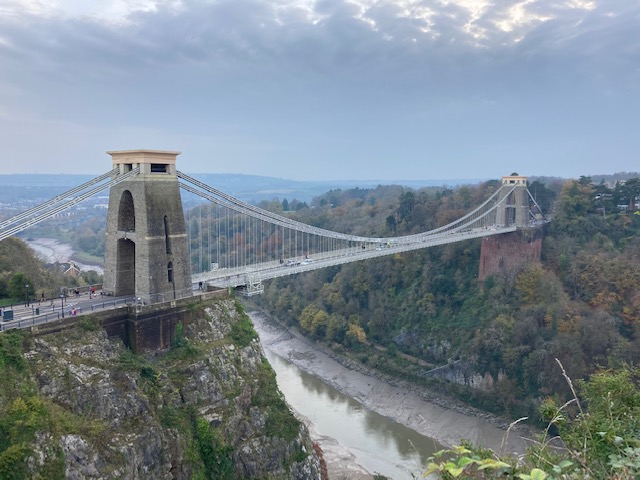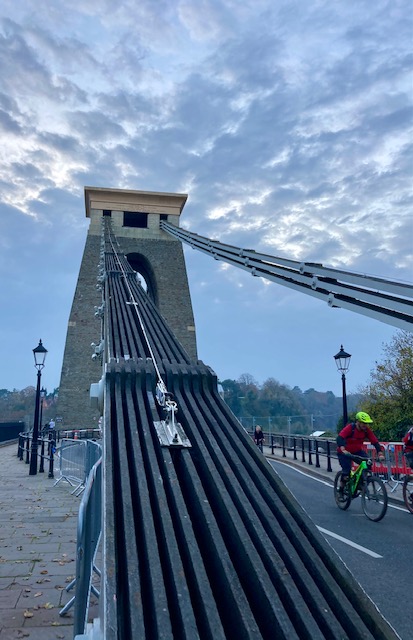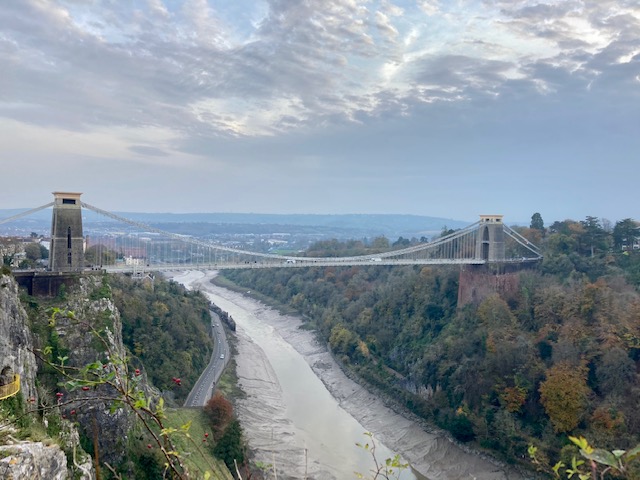Clifton Suspension Bridge
Contents |
[edit] Introduction
Clifton Suspension Bridge links Clifton in Bristol to Leigh Woods in Somerset spanning the River Avon and the Avon Gorge.
[edit] History
The Clifton Suspension Bridge was built between 1831 and 1864 based on an idea first proposed in 1753. Its completion 111 years later was hindered by financial constraints and political complications.
Initial funding for the project came from a deceased Bristol wine merchant named William Vick whose idea a bridge was. When he died in 1753, Vick left £1,000 in his will along with specific instructions to use the money (and the accumulated interest, once it reached a total of £10,000) to construct the bridge.
By 1829 the funds had grown to £8,000. While this was considered insufficient for the entire project (which was expected to cost as much as 10 times more), it was enough to prompt organisers to hold a competition for the best design. This resulted in 22 entries, including four submitted by Isambard Kingdom Brunel. Of the original designs, 17 were rejected on the basis of appearance, materials (Vick's will specified a stone bridge) or cost.
Scottish civil engineer Thomas Telford was brought in to make a selection from the final five entries, and rejected all of them. He then proceeded to produce his own design while additional funding was arranged.
After the Clifton Bridge Bill was enacted in 1830, planners were able to consider designs for a wrought iron suspension bridge (rather than the original plan for stone) that could generate funds through the collection of tolls. Still, the proposed design created by Telford was too expensive; so was a revised one from Brunel.
A second competition held in 1831 resulted in Brunel being awarded the contract as project engineer. It was his first significant commission; he was just 24-years-old at the time.
[edit] Construction delays
The start of construction took place in June 1831. Work stopped during the Bristol Riots, which occurred four months into construction. It resumed in 1836, but halted again in 1843. At this point, only one aspect of the project was complete and funding was exhausted.
Brunel’s original sphinx-topped towers had been scaled back into a rougher, simpler design. These were constructed on both sides of the gorge. Brunel also designed a device known as ‘the suspended traveller’ (an iron bar and basket) to draw materials and personnel from one side of the gorge to the other during construction.
Work on the bridge would not resume again until 1862. During his lifetime, Brunel would describe the bridge as 'my first child, my darling’. However, he died in 1859 - five years before its completion.
[edit] Resumption of construction
Funds for the continuation of work were raised with help from the Institution of Civil Engineers (ICE). Although Brunel’s colleagues at ICE felt this would be an appropriate memorial to his achievements, some changes were made to his original design. Sir John Hawkshaw and William Henry Barlow worked together to come up with modifications that included widening the road and increasing the number of suspension chains (from two to three).
Modern computer analysis shows that his calculations for the joints between the wrought iron links that make up the bridge's chain were nearly perfect in terms of accommodating the weight they were required to support.
Work restarted 1862 under the supervision of Hawkshaw and Barlow and was completed in 1864.
[edit] Post-construction details
The Clifton Suspension Bridge is now a Grade I listed structure, recognised for its achievements in engineering. Despite the delays, it is considered by some to be one of the most significant projects built during the Victorian era.
There are several noteworthy details about the bridge.
- The toll that is collected for crossing the bridge goes towards its maintenance.
- The bridge towers are not identical. The Clifton side tower has cut outs while the Leigh Woods sides have pointed arches. In 2002, 12 chambers and tunnels were discovered in the Leigh Woods tower.
- The bridge spans 214 metres (702 feet) between its two towers and stands 76 metres (245 feet) above the River Avon at high tide.
- The bridge weighs 1,500 tonnes. It is made up of 3,500 load bearing bolts and chains that stretch 20 metres below ground (not 20 miles - this is an often repeated mistake which originated from a misprint in a book).
This image shows how the Clifton tower (left) differs from the Leigh Woods tower (right).
[edit] Legends of the bridge
Folklore associated with the bridge includes the story of a heartbroken young woman named Sarah Ann Henley who attempted suicide by jumping from the bridge in 1885. According to the tale, her effort was thwarted by her voluminous skirts and weather conditions. Her skirts were lifted by strong gusts of wind, which served to parachute her safely to the muddy banks of the River Avon. Although a cabman refused to take her to hospital due to her dirty condition, she was eventually examined by medical professionals who said she was unharmed, although suffering from shock. She later married another suitor and died in 1948 at the age of 85.
The Clifton Suspension Bridge is also associated with the English engineer and inventor, Sarah Guppy (5 November 1770 – 24 August 1852). As the first woman to patent a chain bridge, Guppy came up with her version in 1811. Guppy's design was never executed and is not thought to have had any impact on Brunel's plans for the Clifton Suspension Bridge. However, her son, Thomas Guppy, did work with Brunel on the SS Great Britain and other projects.
[edit] Related articles on Designing Buildings
- Bridge construction.
- Bridges of the world.
- Bridge structures.
- Civil engineering dream projects.
- Five bridges worth visiting during a UK staycation.
- Funicular.
- Going the extra mile to extend the lifespan of the Menai Suspension Bridge.
- Institution of Civil Engineers ICE.
- London Bridge and its houses, c1209-1761.
- Navigable aqueduct.
- Pylon.
- The architecture of British bridges.
- Who is the greatest engineer?
- Wrought iron.
[edit] External resources
- Clifton Suspension Bridge Trust, Did Sarah Guppy Design The Clifton Suspension Bridge?
- Clifton Suspension Bridge Trust, Stories From The Archives: Sarah Ann Henley (8 July 1862 – 31 March 1948).
Featured articles and news
Homes England supports Greencore Homes
42 new build affordable sustainable homes in Oxfordshire.
Zero carbon social housing: unlocking brownfield potential
Seven ZEDpod strategies for brownfield housing success.
CIOB report; a blueprint for SDGs and the built environment
Pairing the Sustainable Development Goals with projects.
Types, tests, standards and fires relating to external cladding
Brief descriptions with an extensive list of fires for review.
Latest Build UK Building Safety Regime explainer published
Key elements in one short, now updated document.
UKGBC launch the UK Climate Resilience Roadmap
First guidance of its kind on direct climate impacts for the built environment and how it can adapt.
CLC Health, Safety and Wellbeing Strategy 2025
Launched by the Minister for Industry to look at fatalities on site, improving mental health and other issues.
One of the most impressive Victorian architects. Book review.
Common Assessment Standard now with building safety
New CAS update now includes mandatory building safety questions.
RTPI leader to become new CIOB Chief Executive Officer
Dr Victoria Hills MRTPI, FICE to take over after Caroline Gumble’s departure.
Social and affordable housing, a long term plan for delivery
The “Delivering a Decade of Renewal for Social and Affordable Housing” strategy sets out future path.
A change to adoptive architecture
Effects of global weather warming on architectural detailing, material choice and human interaction.
The proposed publicly owned and backed subsidiary of Homes England, to facilitate new homes.
How big is the problem and what can we do to mitigate the effects?
Overheating guidance and tools for building designers
A number of cool guides to help with the heat.
The UK's Modern Industrial Strategy: A 10 year plan
Previous consultation criticism, current key elements and general support with some persisting reservations.
Building Safety Regulator reforms
New roles, new staff and a new fast track service pave the way for a single construction regulator.


























